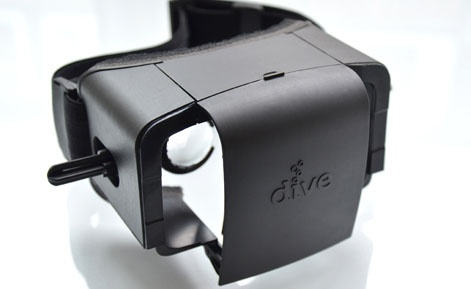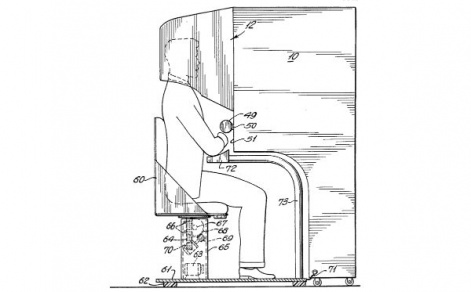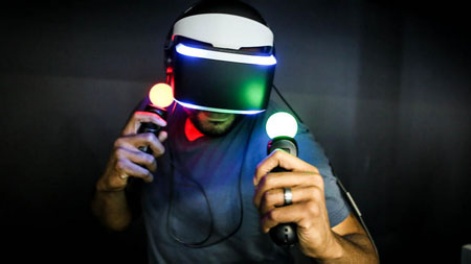There's plenty of excitement and hype in the VR gaming world, but when it comes to the retail opportunity, dedicated head mounted displays (HMDs) like the Oculus Rift and Project Morpheus continually keep their distance.
Perhaps we're not as close to virtual reality gaming as we've been lead to believe, but we still have to wonder what's taking so long. What does consumer VR need to make it ready, and where is it?
We asked out Wearable Mavens group to shed some light on the subject, posing the following questions:
After all the hype and public enthusiasm, why haven't we seen a retail-ready virtual reality headset yet?
And what features/support do you think a consumer VR headset really needs in order to kick off the VR gaming explosion?

Sc0tt Games is run by Scott Harber, an eleven-year games industry veteran whose previous credits include The Getaway, Black, Burnout 3, Burnout Revenge, Burnout Paradise, Need for Speed Hot Pursuit, Need for Speed Most Wanted, Need for Speed Rivals, and Battlefield Hardline.
Personally, I would argue with the initial assertion. Between Durovis Dive, Homido HMD, Google Cardboard, and the upcoming Gear VR, we have already seen at least four retail-ready headsets on the market. The key issue is that, despite the impressive visuals that VR gaming can provide, none of these devices have "caught on" with the consumers.
When you put your phone inside a VR headset and strap it to your face, you sacrifice 100 per cent of your original interactivity.Scott Harber
Right now, mobile VR is a bit of a superficial curiosity for consumers, because there aren't many available games that make the hardware worth purchasing. But as with all new hardware, it won't catch on until someone writes the fabled killer app; the product whose awesomeness both sells the hardware and encourages other developers to write for it.
However, no developer will invest the money or effort into creating the killer app until there's some consistency in the devices.
My belief is that the reticence of mobile developers to support VR comes from the issue of interactivity. Of the four headsets I listed earlier, no two have the same control system.
Case in point: When you put your phone inside a VR headset and strap it to your face, you sacrifice 100 per cent of your original interactivity. For example, you can no longer touch the screen, and while you can still tilt the device, the tilting doubles as head-tracking, effectively nullifying it as an input method.
I have yet to see any mobile VR headset that solves the issue of interactivity completely. If the hardware requires its users to attach a Bluetooth controller, then the hardware has failed at a design level (with that many mandatory peripherals, it's no longer mobile gaming). Similarly, Cardboard's magnet button is a nice compromise that ultimately limits interactivity to a single button press. Gear VR's touchpad is a step in the right direction, but blindly operating a tiny touchpad with no context for the position of your finger is a far cry from the touch controls on an ordinary phone or tablet.

Even if each of these input methods became a standard in their own hardware, as a developer, which one am I writing for? If a developer picks a control method, they "pick a side", and divide their install base accordingly. This is seldom something that developers are eager to do, and this reluctance has the effect of limiting the number of available VR games, thereby limiting VR gaming itself.
Personally, I don't believe that the perfect mobile VR control system will come from aping existing mobile or desktop controls. I don't think that we've seen the perfect mobile VR control system yet. But I do think that only when as much thought and effort has been put into the interactivity as has been put into the visual effect of VR, will we see the VR gaming explosion.

Game Designer/Developer programmer, artist and cosplayer.
Pixel rift is a reflection of my life experience playing games since I can remember.
This game is my final Project is for my masters degree in Games Design and Development at The National Film & Television School. Back in Brazil I ran my own Pie business, but that's another story.
I almost forgot to report that I also love cooking sushi and no one beat me eating ice cream.
We've all been excited about virtual reality for a long time, but the technology wasn’t ready until now. It's required a combination of the progression of 3D graphics and networking technology. To nail the virtual reality experience, we need to make people believe in the virtual reality and forget that it's all artificial.
We have the knowledge and technology to make VR finally work.Ana Ribeiro
It's all about our perception of reality which comes from what we see, feel, touch, and so forth. If those processes receive data that meets their parameters then our body will believe it's real. We need a whole system that captures head tracking, eye tracking, face tracking, hand tracking and whole body tracking. Basically as much tracking as we can get!
We understood this theory a long time ago when back in 1957 the cinematographer, Morton Helig, created The Sensorama Machine, which was designed to create an immersive experience using our sensory perceptions. You could sit in this cabinet surrounded by multiple screens that simulated riding on a motorbike through New York City. The participant could enjoy the ride by receiving corresponding vibrations, head movements, sounds, smells, and even rushes of wind.
We're on the right track. Virtual reality is all about feeling presence in the world - feeling, touching and seeing the world - but because of limited and expensive systems the visual recreation of this world was too far behind for this to be achievable. Also, there was no Kickstarter back then for Morton Helig to get funds to continue his research.

Nowadays we have the knowledge and technology to make VR finally work. I believe that VR won't just kick off in games. This is just the beginning. VR is a new media and not just a new gaming platform. It'll change the way we behave in our lives. Ways like going to school, work, travelling, buying products, interacting with others. In the next 10 years VR will be everywhere because it's such a unique media. You won’t hear, see or talk about the experience. In VR, you'll live it.

Senior Programmer at @ticktockgames. Director of @retroburngames. Crafting games for Console, PC, and Mobile.
We're on the verge of seeing actual consumers get their hands on VR right now. The Gear VR is set to be released this month and while it's still aimed at enthusiasts (requiring a Galaxy Note 4 to use the headset), it's the first stepping stone in seeing how the general mobile game-playing public reacts to VR. I'd love to see people wearing the Gear VR out in public in the next six to 12 months, whether it be on a train, plane, or sat on a park bench enjoying some VR or AR game.
Sony is just keeping up with what Oculus is doing, but it has a fixed platform.Martin Caine
Technology-wise there are a number of limitations which must be overcome, as John Carmack put so well in his recent speech at the Gear VR announcement. The technology to portray digital worlds in VR just isn't there yet. Even the fastest gaming rigs would struggle to run some of the latest games if they had to render from two viewpoints and add in all the head and body tracking required for a fully immersive VR experience. We can settle for running on lower graphics settings or lower resolution, but it's still far from being the perfect VR experience. These first few devices we're seeing now are going to be the first steps towards something truly great in the next five or 10 years.
Owning an Oculus DK1 and Oculus DK2 I can see the vast difference between the two systems. Not so much in terms of graphical fidelity but in the way the device works and immerses you in whatever game or demo you're playing. I hope Oculus continues to innovate like this over its next few iterations, and even if it does release a consumer version in the next few years I imagine it'll be iterating almost every year for some time to come.

As far as I can see it, Sony is just keeping up with what Oculus is doing, but it has a fixed platform. Developers creating games for Morpheus know what the PS4 can do and have guidelines to maintain framerate and to keep motion latency to a minimum.
Sony might bring VR to the game playing masses with PS4 but Oculus will bring it to the world at large. The potential for the use of VR outside of games is huge, but games is where it will start. And it's our job to show off what these VR systems can do to help push them ahead in the future so that cleverer people than us can come up with truly awesome applications for VR that we can't even dream of.

In November 2012, I quit my job, moved across the country, and started working full-time as an indie game designer. My second commercial title was Bombball for Ouya, Mac, and PC. In late 2013, I won the Oculus VR Jam with a prototype called Ciess. Now, I’m working on turning Ciess into a full game called Darknet, set to release alongside the Oculus Rift. It’s by far the largest project I’ve ever worked on.
So far, this whole game development thing has been awesome.
With virtual reality, "pretty good" is unacceptable. If the latency is too high, or if the resolution is too low, or if any of a dozen other factors is subpar, the experience as a whole could be ruined.
First impressions are going to matter a lot.E McNeill
If VR is going to succeed, the quality bar needs to be set high. There's a huge gap between Crescent Bay and DK2. There's a huge gap between Gear VR and Google Cardboard.
It's not easy to explain in simple, objective terms, but the difference is enormous.
There's good reason for caution, too. The VR community is acutely aware of the rise and fall of VR in the 90s, and even now the spectre of nausea could be enough to keep VR from reaching mainstream success. There are a lot of companies rushing to get involved in VR hardware, but from what I've seen, only Oculus, Sony, and Valve are serious about getting it right. I hope they take their time, because first impressions are going to matter a lot.

My big three reasons why there hasn't been a consumer product is because the tech isn't quite ready for everyone, the right input device hasn't been finalised, and because there isn't enough compelling content yet.
VR is hard to get right. And when getting it wrong results in nausea and discomfort that can taint VR for generations to come, it's important to get it right, and Oculus knows this.
When developing the Jump Program for The Matrix VR, I accidentally cured myself of my fear of heights. That's powerful.Tipatat Chennavasin
What Oculus has done with the DK2 is amazing and is a great solution for a decent amount of folks, but there are still some issues with it that have already been addressed with the Crescent Bay prototype it showed off at Oculus Connect. If that's what CV1 will be, then the technical critics will finally be silenced.
Now that we can finally inhabit these virtual worlds, we realise how unnatural the standard computer and game controllers are. Motion controls and gesture based systems finally make a lot more sense, but none has the reliability and price point to become the standard so far. Lots of people are working on it but until the breakthrough that was the keyboard and mouse for the standard computer is found for VR, it'll be hard to design quality experiences.
The input is most critical for the last and most crucial part: making compelling content. People often get hung up thinking about the mythical killer app, but really it will be a critical mass of apps or experiences that will make VR adoption explode. And it's experiences that are built from the ground up, with the strengths of VR at the core of the design that will be the most compelling.

That's not to say there isn't already a lot of really compelling experiences out there, but I think we're just scratching the surface. But that was why it was great for Oculus to release the DK1 and then the DK2 and get it in the hands of as many devs as it could.
Just a personal anecdote, when developing the Jump Program for The Matrix VR, I accidentally cured myself of my fear of heights. That's powerful.
Right now it's in the hands of 100,000 people. I can't wait to see what happens when it's in the hands of millions.
VR isn't a game changer, it's a world changer.






















